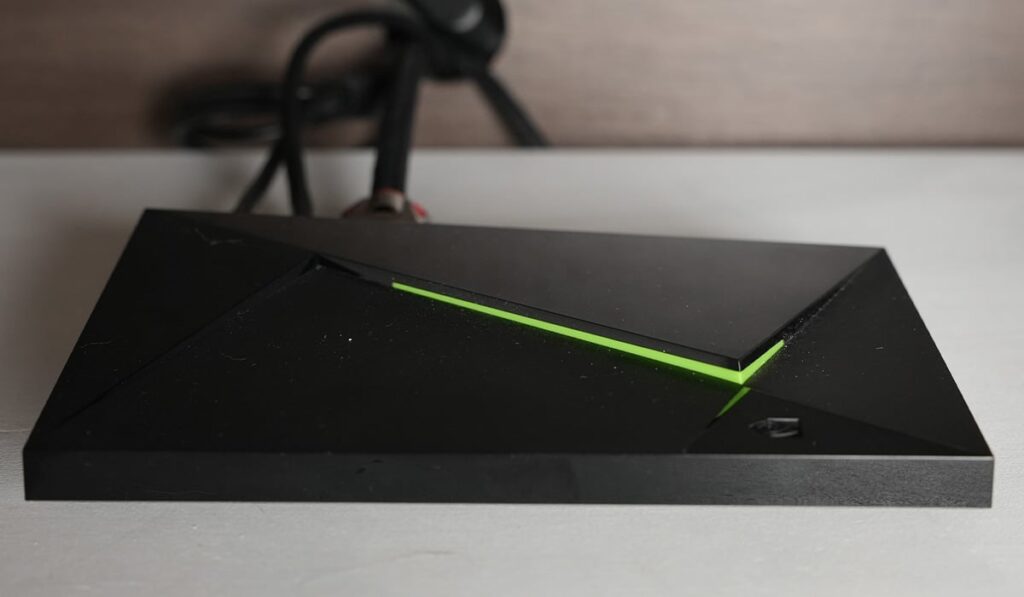Digital streaming is quickly becoming the new normal, which explains the popularity of the Nvidia Shield TV media player. The perks of this device can be further enhanced by the amazing surround sound audio offered by Dolby Atmos. So the big question is: does an Nvidia Shield TV support Dolby Atmos?
The Nvidia Shield TV supports Dolby Atmos as well as Dolby Digital, Dolby Digital Plus, and Dolby TrueHD. It also supports various DTS audio codecs. You must use HDMI to get Dolby Atmos from the Nvidia Shield TV to a soundbar or A/V receiver.
In this article, we will review the different ways to connect the Nvidia Shield to your AV receiver or soundbar and TV to get Dolby Atmos sound. The configurations will partly depend on whether your devices and media support Dolby Digital Plus or Dolby TrueHD.
Key Takeaways
- Dolby Atmos on Nvidia Shield: Nvidia Shield TV enhances audio with Dolby Atmos, supporting other formats as well, but the content has to also be serving Dolby Atmos sound.
- Connection Options: Link the Nvidia Shield TV to the AV receiver or Atmos soundbar for Dolby Atmos or use HDMI ARC via the TV's HDMI ARC or eARC port.
- Troubleshooting Tips: Address Dolby Atmos issues by verifying HDMI connections, ensuring correct audio settings, and checking app-specific settings.
What Is Dolby Atmos?
Dolby Atmos is the most popular audio format from Dolby, offering 3D surround sound technology similar to those found in huge cinemas. The technology includes an additional height channel to provide a unique enveloping experience to users.
Can the Nvidia Shield Play Dolby Atmos?

Yes, the Nvidia Shield TV (on Amazon) supports various sound formats, including Dolby Atmos. As with all other Android TV devices, it can stream content in 4k resolution from various apps.
Depending on the capabilities of your other devices, such as your TV and receiver/soundbar, the Nvidia Shield TV Pro decodes the best audio format to allow an immersive sound experience through your home theater setup.
Before you begin, verify Dolby Atmos audio compatibility for connected devices to the Nvidia Shield and ensure your receiver or Dolby Atmos soundbar is updated to the latest software for resolving any audio or video incompatibility issues.
How to Make Sure You Have Dolby Atmos on Nvidia Shield TV

Configuring the surround sound setup on a Shield TV is a cakewalk with the right set of devices.
There are two different ways to get Dolby Atmos on Nvidia Shield. Both the soundbar or AV receiver and speaker setup will need to support Dolby Atmos to get Atmos audio.
Option 1: Connect the Shield TV to an HDMI Input on the AV Receiver or Soundbar
This is the preferred option for the highest quality audio when using any media streaming device.
- Use one end of your HDMI cable to connect to your Nvidia Shield TV and connect the other end to one of the AV receiver’s or soundbar's HDMI inputs.
- To ensure the HDMI cable has enough bandwidth, you must use an HDMI 2.0 or higher cable (on Amazon).
- Connect another HDMI cable from the soundbar or receiver's HDMI out port to one of the TV's HDMI inputs (preferably the one labeled ARC or eARC, not required)
- Open Netflix, Disney+, or any other streaming service that has Dolby Atmos content and check for a Dolby Atmos badge below the title.
Option 2: Connect Shield TV to the TV and Use HDMI ARC to Send Audio
If you'd prefer to connect the Shield TV streamer directly to your Television, that's no problem at all, but there are a few things you need to check.
First, you need to make sure your TV has HDMI ARC. Second, you need to ensure that the HDMI ARC port on your TV can pass-through Dolby Digital Plus audio.
The Dolby Digital Plus audio codec is a lossy audio stream that can contain Dolby Atmos metadata. While not all HDMI ARC ports will be able to send this audio codec though, if you have an HDMI eARC port then there's no need to worry at all.
Check out this article to figure out if your TV can send Dolby Atmos audio over HDMI ARC.
Next, follow the below instructions to get everything configured properly:
- Use an HDMI cable to connect the Shield TV to one of the TV's HDMI inputs (NOT the one labeled HDMI ARC).
- Connect an HDMI cable to the TV's HDMI port labeled ARC or eARC, then connect the other end to the AV receiver or soundbar's HDMI Output/ARC port.
- Go to the sound settings on your TV and make sure HDMI ARC and/or CEC are enabled.
- Also, make sure that any Dolby Atmos setting is enabled.
- Open any other streaming service app (Netflix, Disney+, etc.) that has Dolby Atmos content and check for a Dolby Atmos badge below the title. Usually, most Netflix originals have Dolby Atmos audio, so it's easiest to check those.
The Shield TV supports HDMI-CEC, enabling control of the TV, AVR, soundbar, etc. through Shield's remote; configure this in ‘Power control' under ‘Display & Sound.'
Troubleshooting Dolby Atmos Not Working on Nvidia Shield
To resolve Dolby Atmos issues on your Nvidia Shield, ensure compatibility with Dolby Atmos devices, restart all devices, and if that doesn't help, follow these common troubleshooting steps.
Check HDMI Connection:
- Confirm that your Nvidia Shield is connected to your TV or AV receiver using an HDMI cable.
- Use a high-quality HDMI cable that supports the necessary bandwidth for Dolby Atmos.
Audio Settings:
- Navigate to the Nvidia Shield's settings and check the audio settings.
- Ensure that “Dolby Atmos” is selected as the audio output format.
App-Specific Settings:
- Check the audio settings for Dolby Atmos within the specific streaming apps you're using (e.g., Netflix, Disney+, etc.).





